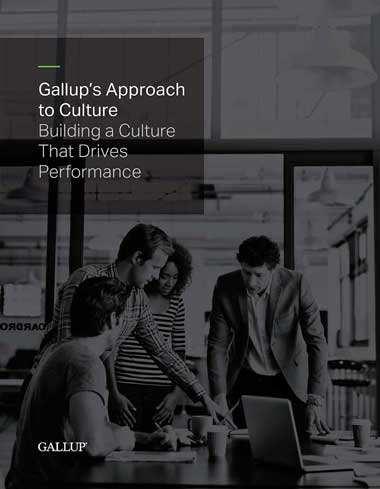Story Highlights
- Customer engagement is about the way you make a customer feel
- You must deliver consistent emotional experiences to engage customers
- Customer-facing employees must be engaged to deliver the brand promise
This is the sixth article in our series for restaurant leaders about The Golden Thread, Gallup's strategy for getting ahead of your restaurant competition. Read the first, second, third, fourth, fifth and seventh articles in this series.
There's a sushi place a friend of mine loves like crazy. She says it's similar to every other Japanese restaurant in her town, except for one thing: "Every plate is little work of art."
Food arranged like flowers, flowers that are food, elaborate sculptures made of barware, noodles and tea lights - she's so delighted by the operation's "talent, creativity and care," that this restaurant is, to her, synonymous with eating out.
My friend is an engaged customer, the kind every restaurateur needs. Not wants, needs because in today's slow-growth, competitive food service environment, the customer has extraordinary power and reach.
Restaurants have to deliver a consistent, engaging experience at every single location, on every single channel, every single day, for every single customer.
Sixty-one percent of Americans ate out at least once in the past week, Gallup research shows, choosing from an endless list of dine-in and delivery options. Establishments they can choose to post a public review of online -- while the food is still hot. And these critiques can go viral in a hurry.
That's real consumer power.
To meet the challenge it presents, restaurants have to deliver a consistent, engaging experience at every single location, on every single channel, every single day, for every single customer.
Engagement Drivers
I mentioned above that my friend is an engaged customer. Gallup defines customer engagement as an emotional and rational attachment to a product or business.
And that engagement? It's lucrative. According to Gallup's research, customers who are fully engaged represent a 23% premium in terms of share of wallet, profitability, revenue and relationship growth over the average customer.
To understand what brings customers in and keeps them coming back, leadership needs to understand customers' emotional and rational attachment -- and their spending.
Emotional drivers aren't about the quality or taste of your food -- these are just table stakes in today's world, and any restaurant can replicate them.
Customer engagement is about experience, specifically the way a restaurant makes a customer feel -- welcomed by the overall atmosphere, cared for by the friendly service, delighted by the talent and creativity of artistic chefs.
Customer experiences should be unique to you, at least a little, but always aligned with your purpose, brand promise and values.
Different outlets require different expressions of those things, but whether dine-in, delivery, take-out or catering, the brand experience should be maintained.
In fact, Gallup data shows that food and beverage customers who are familiar with and aligned with your brand give you 39% more share of wallet.
Customer engagement is about experience, specifically the way a restaurant makes a customer feel -- welcomed by the overall atmosphere, cared for by the friendly service, delighted by the talent and creativity of artistic chefs.
When you have determined the most engaging experiences you can deliver consistently -- across all channels and every outlet -- correlate them with your customer performance metrics to assess your progress. That's critical for positioning your service operating model.
A winning service operating model is a great differentiator in the competitive U.S. market, but it should be built into the system in foreign expansion efforts, too.
In every case, understand what the data is telling you, create a plan, follow up on that plan and make changes when you need to.
Just don't take your eyes off the data that tell you about your customers' feelings and experiences.
A net promoter score tells you if customers are willing to recommend you, which is helpful. But it doesn't reflect customers' emotional engagement, which is a much more powerful driver than overall satisfaction.
To that point, fully engaged casual dining customers make 56% more visits per month to that restaurant than the actively disengaged do. Fast-food customers make 28% more visits.
Those customer metrics and the strategy for how to maximize them are in leadership's hands. But all the data in the world won't help managers unless leadership gives them tools they can use to create a consistent customer experience.
One of the most beneficial tools is a system to sustain employee engagement for customer-facing team members. Their engagement numbers are important -- and too often undervalued.
That's a serious mistake because the people nearest the customer have considerable power over their experience.
Customer Facing
To a customer, the folks on the floor are the brand promise.
Indifferent team members won't go to the trouble of delivering on the brand promise, and the actively disengaged won't mind if they drive customers away.
So customer engagement and experience is downstream from employee engagement, and both largely depend on the local manager: 70% of the variance in their engagement comes down to their manager, Gallup finds.
Leadership can help local managers engage team members, deliver a consistent brand experience and ultimately engage customers by doing these five things simultaneously:
Identify the experiences that create customer engagement.
Align them with culture, purpose, values and brand promise.
Make sure they're deliverable across all channels consistently, yet are still specific to the needs of each channel's customers.
Draft specific, actionable, and correlated behaviors aligned with culture, purpose, values, and brand promise that managers can put into action.
Hold managers accountable for consistent delivery of these behaviors.
It's a lot, but today's customers expect a lot. In fact, leaders who place employee engagement and customer engagement data in one graph get a resulting picture of what matters most to customers. That's the qualitative and quantitative data that drives your business.
But a manager can only use the tools leadership gives her.
Field support helps by assessing local metrics and reporting them contextually to HQ. But leaders design the systems that sustain culture, employee engagement, customer engagement and the brand promise. If those systems don't support those things, leaders undermine managers -- and ultimately, their own business.
The Way to a Customer's Heart
And that's why I used my friend's favorite sushi place as an example. Her response shows that the leadership there is doing everything right.
When people gasp and take pictures of their plates, they're building your market for you on social media.
They could go with authenticity, or lower their prices, or flood the market with locations. But those strategies are easily emulated.
Instead, they allow their chefs to go nuts with presentation, in a way only their chefs can. To make every meal an engaging event.
My friend's reaction shows it's a winning decision: Every single visit, her plate makes an appearance on her Instagram feed.
Word of advice -- when people gasp and take pictures of their plates, they're building your market for you on social media. Follow their feeds and tell the stories behind the meal to heighten the customer experience.
My friend's favorite sushi place has leaders who know how to strategize -- and I'd bet they're executing every point on The Golden Thread with excellence.
And that's why customers are the fifth, not first, point on The Golden Thread. All the previous points on The Golden Thread must be properly used to create customers -- engaged ones, anyway. It's complex, difficult and intensive.
But it's also a clear path. The way to a customer's heart and wallet is by being yourself -- and different from every place else -- with a consistent, emotionally engaging experience at every single location, on every single channel, every single day, for every single customer.
Gallup can help you create consistent experiences that engage your customers:
- Partner with us to make employee engagement central to your business strategy.
- Get human-centric advice for your guest-centric business.
- Read our report State of the American Consumer to gain insights on how to improve customer engagement.





